|
Preview
April 17, 2006
Pe-2
and Pe-3 for IL-2 Forgotten Battles
by Guest Writer Ian
Boys
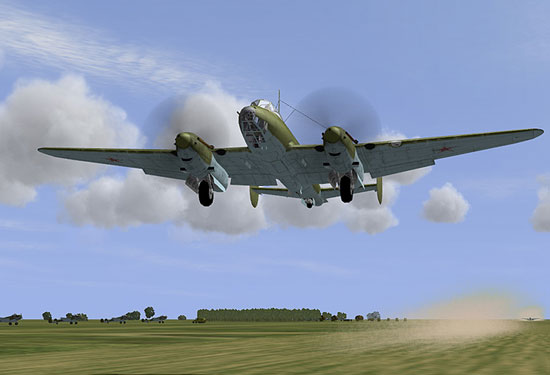
Disclaimer:
In line with SimHQ's interest disclosure policy I would
like to state that I have a commercial relationship with
1C, the parent company of Maddox Games who have produced
the PE-2/PE-3 Add-On for IL-2. 1C are the Russian distributors
for my Ostfront product.
- Ian Boys
Add-on Contents
- 4 flyable PE-2 variants
- 2 flyable PE-3 variants
- Extensive Read-me for the new aircraft
- 4 campaigns - 2x PE-2 (Airforce
and Navy), 1x fighter, 1x IL-2
- 5 PE-2 Cooperative multiplayer
missions
- 5 PE-2 and PE-3 Single player missions
- A PE-2 Bombsight Training Mission
- Many new skins for the PE-2, PE-3,
Yak-1b, La-5 and others
- New German and Russian vehicular
and static AA guns
- New German and Russian artillery
and antitank pieces
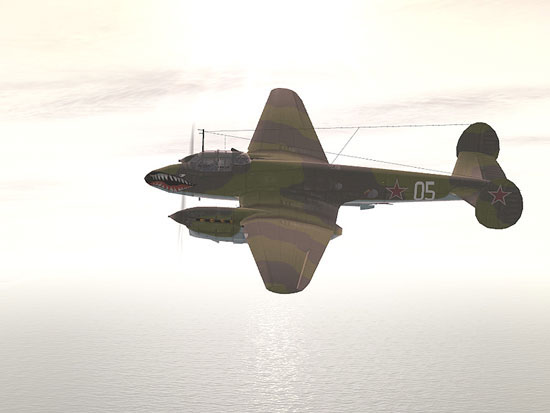
The PE-2
Vladimir Petlyakov, the designer who
produced the most widespread and versatile of the many Soviet
bomber designs of World War II, was a prisoner of the NKVD
when he first drew the "100" high altitude fighter,
the forerunner of the PE-2 and PE-3 aircraft and it was in
a special prison camp that the twin-engined, twin-rudder aircraft
progressed from concept to reality (see Soviet Combat Aircraft
of WW2 by Ye. Gordon and D. Khazanov, Volume 2).
The "100" was designed as
a fast interceptor not unlike the Messerschmitt Bf-110. However
the successes in Poland and France of the Ju-87 and Ju-88
dive bombers meant that the Russians were looking for a precision
instrument of their own. Polikarpov's SPB was proving unsuccessful
and Archangelskiy's conversion of the Tupolev SB was looking
pessimistic. The Russian purchase in 1940 of a Ju-88 suggested
the similar "100" as a possible conversion. Petlyakov
was released from prison in the summer of 1940 and with a
host of designers from the competing but unsuccessful design
teams drafted in, he set to work. The navigator and pilot
were moved into a single cockpit and glass was placed in the
nose to aid landing and target spotting. Sights for level
and dive bombing were added, together with defensive machine-guns
for the upper and lower hemispheres.
The PB-100 was redesignated the PE-2
in December 1940, the same month as its first flights. Testing
by the Red Airforce revealed 187 defects. Most were quickly
resolved but some remained as "features" of the
PE-2 throughout its service. Chief among them was the tendency
to stall during landing if the angle of attack exceeded 11
degrees. This was caused by the wing design originally intended
for the high-altitude fighter and kept for the PE-2
The bomber entered service at Moscow
and Kiev but by the time of the German invasion, 180 were
serving in the frontier Military Districts. First encounters
with German aircraft were encouraging — unlike the SB,
the Pe-2's could parry enemy attacks and gain rare victories
even over the nimble Messerchmitt Bf-109's. A raid on Ploesti
in Rumania confirmed the bomber's ability — 250,00 tons
of oil was set alight. Nevertheless, the defects were also
apparent: insufficient defensive armament, a high fire risk
and insufficient armor for the navigator and gunner.
Defensive armament was improved —
from August 1941, three defensive guns were carried. One was
fired by the Navigator from his position in the main cockpit.
The Radio Operator/Gunner in the fuselage had two guns —
one covering behind and below from the ventral hatch and one
that could be switched from side to side to fire from small
portholes. These guns were initially of 7.62mm caliber but
the turret and ventral guns were later upgraded to 12.7mm.
Armor was improved, especially for the Navigator and Gunner,
as was the inert gas system that protected against fire. Still,
ten gunners were wounded for each wounded pilot, and two or
three gunners killed for each dead pilot.
The PE-2 first came to prominence
during the battle to defend Moscow that began in October 1941,
where they flew the most important attack missions. A number
of modifications were also attempted, from rockets to airborne
searchlights to counter German night bombing. Thereafter the
PE-2 spread to every front, carrying the burden of daylight
bombing, reconnaissance and maritime surveillance until the
end of the war.
Go
To Page 2
Preview: PE-2 and PE-3 for IL-2 Forgotten
Battles
Back To Page 1

The PE-3
There
is a good reason why the skies of 1945 were not full of fast,
heavy twin-engined fighters like the PE-3 or the BF-110 They
just were not good general-purpose day fighters. The PE-3,
in particular, is fast but not fast enough, it has a poor
roll rate and it is dangerous to turn-fight in. Give me a
Yak any day.
That
is not to say that the PE-3 has no place in missions. If you
need an aircraft to stooge around for hours up at 6000m on
the approaches to Moscow, the PE-3 will do it, as long as
bombers are the target. If you need to cover a convoy approach
Murmansk from torpedo bombers, the PE-3 is ideal. Those natty
little P-40’s may be handier in a fight but won’t
make it back over 100 miles of freezing Arctic seas with an
engine shot out by bomber defensive fire, as Froktistovich
found out the hard way. Having two engines looks a lot cleverer
when there’s nowhere to land.
It may be worth mentioning that there
were in reality two main versions of the Pe-3bis. The later
version had a gun that fired under the tail instead of straight
back, but we have the early version. That accounts for differences
in profiles etc.
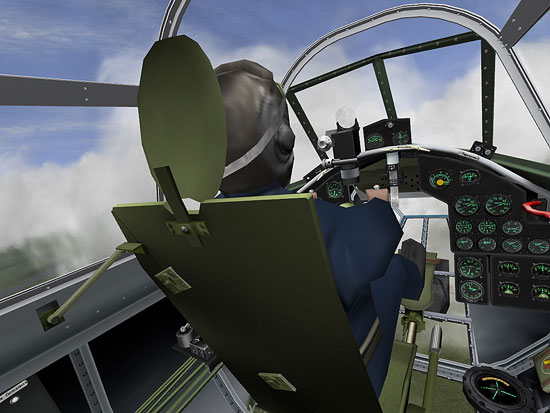
The Cockpits
I have mixed feelings about these
– they score very highly in the functionality stakes
and lower for aesthetic appeal. They are not beautiful in
the way Vraciu and Hammerd’s Tempest cockpit is. They
do, however, offer all kinds of useful gadgetry – from
the standard direction indicator to flap position warning
lights, over-G warning light, trim neutral light and the very
useful “bombs gone” lights. Several of the standard
gauges are also now more detailed, for example the fuel gauge.
The level bombing sight is a work
of art. It is a completely new design and for the first time
contains a spirit level bubble to make it easy to ensure absolutely
level flight while glued to the eyepiece. No need for a constant
speed/trim battle anymore – it’s a simple and elegant
solution. It is also worth noting that there is no automatic
bomb release — you
still need to toggle them off manually when the indicators
meet.
The real PE-2 carried both day and
night sights and here we notice a problem: the level bombing
sight is marked in black. It would have been nice to have
an illuminated version for low light work as on the real aircraft
but I recognize that only a tiny handful of simmers enjoy
night missions and this omission is one that will largely
pass unnoticed.
More important is the nonfunctional
PBL-1 dive-bombing sight. Given its position in the cockpit
it would perhaps have been impractical to implement, if not
impossible. Still, it is in the nature of dive-bombing that
you point the aircraft straight down and let go through the
gunsight and probably few of us bother setting the Stuvi in
the Ju-88 for 50 degree dives. So it’s a pity, but certainly
not critical.
Another limitation is the tail stinger
gun in the PE-3 As with the Heinkel bomber, this only works
on AI aircraft, but it would certainly be useful with a Messer
on your tail.
There are lots of nice touches —
look over your shoulder in the gunner cockpit and, reassuringly,
the pilot is there. The gunner cockpits are sparse but effective,
varying from a 7.62mm machine-gun in the early “tortoiseshell”
hatch to a more effective .50 caliber gun in a proper turret.
Actually, given the vulnerability of the Messerschmitt engine
to light caliber hits, the 7.62mm with its higher rate of
fire is probably a better bet early on anyway. You’ll
want the heavier gun once the Fw-190 appears though.
The PE-2
(but not the PE-3) carried three members of crew but only
two positions are modeled. This is probably wise as the third
was stuck inside the hull hemmed in by radios and with limited
views. He had two guns to operate in three mountings and,
as with the Ju-88, allowing the player to do this would have
caused AI problems.
To sum
up, the cockpits are effective but graphically a step below
the best recent work. It is also nice that the cockpits change
as the PE-2/PE-3 grows up — from different gunsights
to different toggles on the gun rechargers. You are always
flying a PE-2/PE-3 but with small differences.
Go
To Page 3
Preview: PE-2 and PE-3 for IL-2 Forgotten
Battles
Back To Page 2
Flight Model
The real
PE-2 had challenging flight characteristics due to the fast
wing. This made it difficult and prone to stalling at low
speeds and high angles of attack, causing several fatalities
in landing accidents.
The PE-2
we have performs as expected. Landings are best carried out
fast and with plenty of flaps. Maximum sea level speed is
around 440 km/h with 50% fuel and no bomb load. Again, this
is right on the numbers (the maximum speed of the real PE-2
of 452 km/h was only attained with wooden guns, the hatches
smoothed over etc.)
The real
PE-2 had electrical motors in the tail to assist with pull
up after dive-bombing. Our PE-2 pulls up nicely at high speeds
(and this might be a way to shake a human-flown Messerschmitt,
especially if you can pull up into cloud while his elevators
stiffen). The PE-2 did not, however, have assisted aileron
controls, which means they stiffen considerably at high speed.
It is worth slowing down a touch before rolling over into
the dive.
Given
the wing profile and the low AoA tolerance, it is best not
to engage in a turning fight at all. The inside wing will
stall easily and spin you in. This is an aircraft that needs
to stay fast. The best defense against an agile fighter is
scissors/corkscrew at medium speed (about 330 km/h) and relying
on defensive fire. The Messerschmitt with its limited ammunition
and narrow cone of fire can struggle to get a good shot in.
The Fw-190 will have no such problems.
Damage Model
The PE-2’s
wings were packed with fuel and serious damage here will cause
a catastrophic fire. The real PE-2 had an inert gas system
and so low damage will not result in a fire. German 7.92mm
hits stop leaking after 30 seconds and 20mm hits after some
2 minutes. That means you can get back to base with some damage,
pretty important for a plane that may be carrying out raids
deep in enemy territory.
The DM is given to shedding parts
— a rudder here, an engine there. This happens quite
a bit but makes for more interesting missions and landings.
One handy side effect is that if you crash-land with an engine
on fire, you have a good chance of losing it as you scrape
along the ground, which is always good to know.
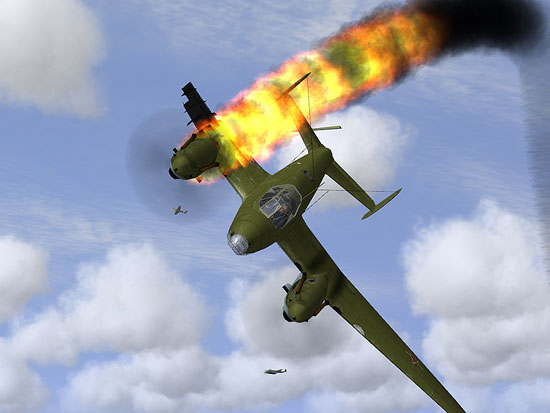
Survivability
Assuming
an enemy pilot who heads home once sustaining engine damage,
the PE-2 has perhaps a 30-40% chance of surviving an attack
by an early Messerschmitt, perhaps 10% vs. a late Messerschmitt
with a 30mm cannon and no chance at all vs. a Focke-Wulf 190,
where you probably will not even get a chance to bail. This
may make it unattractive for some online pilots, although
the figures are probably realistic. With an escort, pilots
will of course have a decent chance and the best idea is to
approach so high that you are not attacked at all. Nevertheless,
I would personally feel happier in an IL-2.
Documentation
Given that we are dealing with a single
new plane type (albeit in six variants) it is a pity that
no space was found for proper pilot notes, such as supercharger
gear change altitudes, mix altitudes etc. These would have
been particularly useful as the wrong settings can cut 40
km/h off your speed at sea level. A guide to dive bombing
in the PE-2, supernumerary for most virtual pilots, would
perhaps also have helped the newer pilot, especially a reminder
to reset the engines for low altitude before diving. In addition,
a couple of tiny errors, not present in the Russian version,
crept into the Western readme. A release focussing on a single
basic airframe and introducing new cockpit elements should
really have had a potted history of the type, some pilot’s
notes, cockpit guides etc., perhaps presented as a 1940’s
document. A thin .txt file does little to round out the package
or engage interest in what, for most, will be an unfamiliar
aircraft.
Go
To Page 4
Preview: PE-2 and PE-3 for IL-2 Forgotten
Battles
Back To Page 3

Payload
One disappointment is the lack of
payload options for the aircraft. Essentially it comes down
to different numbers and weights of iron bomb. Given that
the real PE-2’s were also armed with RS-132 rockets,
AO bomblets, defensive DAK grenades and field modifications
like rearward firing RS-82’s, it seems a shame. Still,
the aircraft is a bomber and dive-bomber so what we have will
cover 99% of missions and the alternatives will probably not
be missed. The fun, after all, is in the dive-bombing!
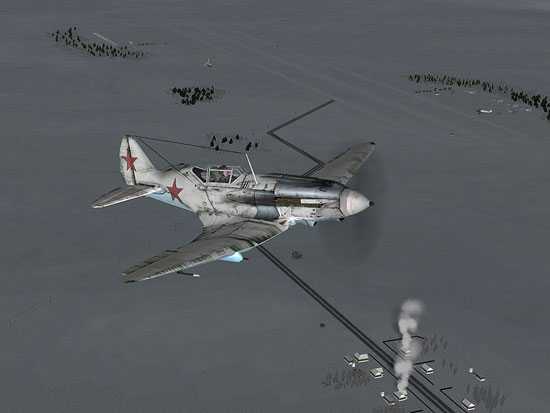
Campaigns
The add-on is marketed as a new aircraft
package, the emphasis on the sleek new bombers. It could easily
have been promoted as a campaigns package with a couple of
aircraft thrown in. The campaigns are that good.
Four campaigns are included:
1) PE-2 Airforce - Army support
on the Kursk and Berlin maps.
2) PE-2 Navy - Fly for the 12th
Guards Divebomber Regiment across the Gulf of Finland and
the Baltic Sea (Leningrad and Kurland maps).
3) Blinding Sun (Cold Winter) -
Defend Moscow against the invader in your MiG-3 then fight
back in your Yak-1B over Kursk.
4) Burning Ridge (Dukla Pass) -
Fly your IL-2 in support of our divisions breaking through
the Carpathians.
The campaigns
offer variety and quality. You start from credible airbases
that are well populated without being overdone. You pass trains,
vehicles on the road and the odd tank battle on the way to
your target. Your escorts may pick off a lone Storch that
is observing your units. The target areas are well laid out
and realistic. Villages in the snow may be destroyed or occupied,
with smoke rising from the chimneys. Air combat can happen
anywhere — not just the standard head-on engagement but
off in the distance or curving in behind you as you turn onto
your bomb run. All the customized quality of a handmade campaign
is here to see. There are lots of very nice touches, like
a damaged plane crash-landing in front of you, tying in with
the briefing you just had.
The briefings
are a work of art in their own right. Ignore the odd bit of
poor English (12th Diving Guards?), poor translation and misspellings
and look at the wealth of detail and character that really
add to the missions. I've never seen briefings this good before.
There are some historical mistakes and the briefings often
assume an outcome to the previous mission that may not have
occurred but within the limitations of the static campaign
they are about as good as can be expected.
As a
campaign builder it gives me both pleasure and a little discomfort
to say that these campaigns are simply the best I’ve
ever seen. Really that good. There is nobody pickier than
I when it comes to inaccuracies in missions, to the extent
that I very rarely play missions made by other people, much
less campaigns. I have no such hesitation here — everything
I have seen rings true for the period and mission type. There
are two minor inaccuracies but I really had to search for
them.
A lot
depends on how you play the missions. With no externals or
map aids, a road recon over enemy territory under low clouds
is hard, constantly updating your position to check the locations
you have been ordered to cover while peering over your shoulder
for bandits coming down out of the clouds just 200 metres
above you. With externals and map aids the same mission can
verge on the pointless — flying a racetrack and hitting
checkpoints in relative safety. I really advise playing them
how they were meant to be played.
Still,
the campaigns are just outstanding and the fighter and IL-2
campaigns are by no means afterthoughts. Indeed, the fighter
campaign is probably the best of the bunch; it is pitched
just right in difficulty and I would never have believed that
a Mig-3 campaign over the generally barren Moscow winter map
could have been so immersive and atmospheric. Nice work Vadson!

Ground Units
The ground
units comprise of artillery howitzers, antitank guns, half-tracks,
half-tracks with mounted AA guns and static AA guns. These,
especially the new German 20mm and 37mm Flak, are excellent
and long overdue. The quality of the ground units is just
outstanding and I would predict the demise in missions of
the old 20mm “naval” Oerlikon in short order. The
Russian truck with the quad Maxim mounting is also striking.
Go
To Page 5
Preview: PE-2 and PE-3 for IL-2 Forgotten
Battles
Back To Page 4
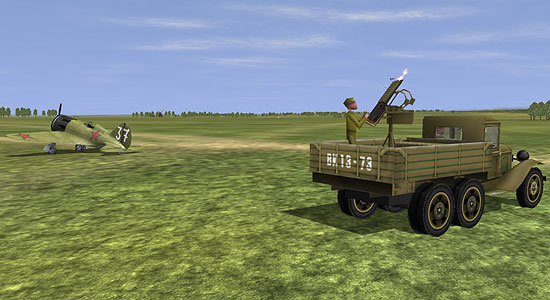
Conclusion
The PE-2 was the main bomber of the
Eastern Front and is very welcome as a flyable aircraft. It
played a major role in all the campaigns of the war from the
defense of the Crimea in the south to the frozen wastes of
the far north. It was central to many of the most dramatic
strikes — the Petsamo
bridge that cut off the German advance on Murmansk, the Niobe
strike at Kotka, the Libau attacks and many more. It served
as a bomber, reconnaissance aircraft and, less successfully,
a heavy fighter.
There are certainly some things that
could have been better —
documentation, payload, some parts of the cockpits.
However there are many things done
very well indeed — the
flight model, damage model, new bombsight, the cockpit as
a whole and the superlative ground objects. The nicest surprise
of all comes from the excellent campaigns which I shall enjoy
playing again.
This is an add-on that Eastern Front
pilots will love and others should try.
We
want your Feedback. Please let us know what you thought of
this article here.
Click
here to go to top of this page.
Copyright 2008, SimHQ.com. All Rights Reserved. Contact the webmaster.
|

